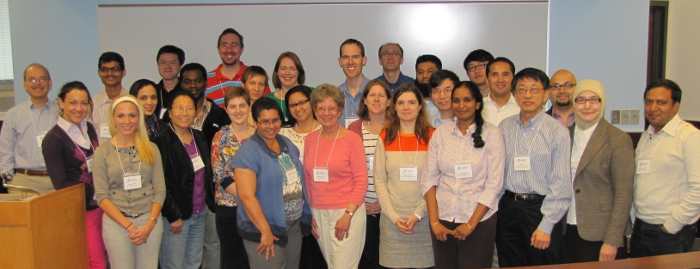| Description | Participants | Agenda (pdf) |
|---|
NIMBioS Tutorial
Mathematical Modeling for the Cell Biology Researcher and Educator

Topic: Mathematical Modeling for the Cell Biology Researcher and Educator
Meeting dates: April 8-10, 2013
Location: NIMBioS at the University of Tennessee, Knoxville
Organizers/Presenters:
Leslie Loew (Director, Center for Cell Analysis and Modeling, University of Connecticut Health Center)
Huaiyu Mi (Division of Bioinformatics, Department of Preventive Medicine, Keck School of Medicine of USC)
Michael Blinov (Center for Cell Analysis and Modeling, University of Connecticut Health Center)
Sofya Borinskaya (University of Connecticut Health Center)
Raquell Holmes (Center for Cell Analysis and Modeling, University of Connecticut Health Center; Founder, Improvscience)
Descriptive flyer (pdf)
Cell Biology Tutorial WordPress site
Evaluation Report (pdf)
Objectives: Cell Biology research spans abundant metabolic and signaling reaction networks, as well as complex spatial structures. Mathematical modeling and simulation of networks and cellular structures involves multiple choices: "How do you wish to construct your network? Is it better to simulate the network as a deterministic or stochastic process? How can we incorporate the spatial information of the cellular structure and molecular distributions? What software applications can I use?" This tutorial introduced and taught participants how to use computational resources for mathematical modeling and simulation of kinetic networks and networks in spatial context.
During the tutorial, we briefly introduced the mathematical foundations of reaction kinetics and different simulation techniques. Participants worked through a series of examples of increasing biological and mathematical complexity. By the conclusion of the tutorial, participants learned the skills needed to build and simulate models of reaction networks, e.g. ligand-induced signaling cascade. Attendees were encouraged to work on models of their own research systems and received assistance from the organizers and presenters. The material presented during the workshop can be incorporated into graduate courses, since it is presently taught to graduate students in biomedical science and biomedical engineering programs at University of Connecticut.
We demonstrated three approaches to creating reaction network models: designing reaction schema, importing pathway information from biological databases (such as Panther or Pathway Commons collection), and using rule-based modeling. The Virtual Cell modeling and simulation platform were used to perform simulations. For spatial modeling and simulations, participants designed compartments using either analytic geometry or imported images, specified species distribution using either analytic methods or data taken from images, and simulated using either spatial deterministic or stochastic methods. Mathematical modeling and simulation of biological systems demand close collaborations between modelers and experimentalists, which is facilitated by standards describing workflows and data formats. We introduced some standard exchange tools used in mathematical modeling: BioPAX (Biological PAthwayeXchange) standard for exchange of pathway data among multiple databases, SBML (Systems Biology Markup Language) standard for exchange of mathematical models among different modeling and simulation tools, and SBGN (Systems Biology Graphical Notations) standard for visual representation of models and pathway data. We will also discuss other modeling tools: Copasi with its powerful fitting capabilities, CellDesigner with its rich cartoon drawing capabilities, and NFSim software that simulates rule-based models that cannot be represented as networks. Together these tools provide a broad coverage of techniques used in mathematical modeling in Cell biology.
Tutorial Organization: The tutorial included lectures and hands-on sessions. We worked one-on-one with participants on implementation of their models. At the beginning and the conclusion of the tutorial each participant presented a short-format talk on their modeling experience, interests and goals. The aim of these talks as to help identify common interests among participants, jump-start new collaborations and refine participants’ ideas concerning model development.
By the end of this intensive course, participants were able to build, test and analyze mathematical models in Cell Biology. To further assist participants with building new models, we provided an overview of pathway and modeling databases with different biological subjects.
A goal of NIMBioS is to enhance the cadre of researchers capable of interdisciplinary efforts across mathematics and biology. As part of this goal, NIMBioS is committed to promoting diversity in all its activities. Diversity is considered in all its aspects, social and scientific, including gender, ethnicity, scientific field, career stage, geography and type of home institution. Questions regarding diversity issues should be directed to diversity@nimbios.org. You can read more about our Diversity Plan on our NIMBioS Policies web page. The NIMBioS building is fully handicapped accessible.
NIMBioS
1122 Volunteer Blvd., Suite 106
University of Tennessee
Knoxville,
TN 37996-3410
PH: (865) 974-9334
FAX: (865) 974-9461
Contact NIMBioS


